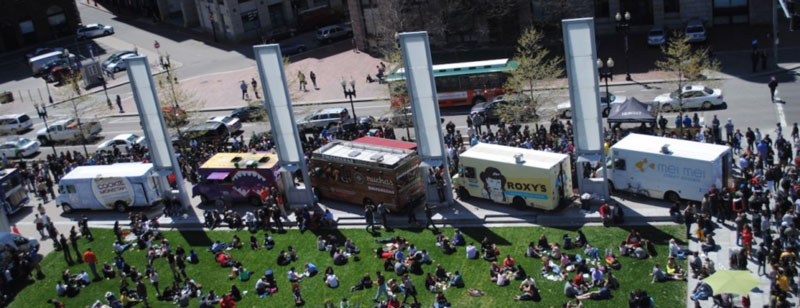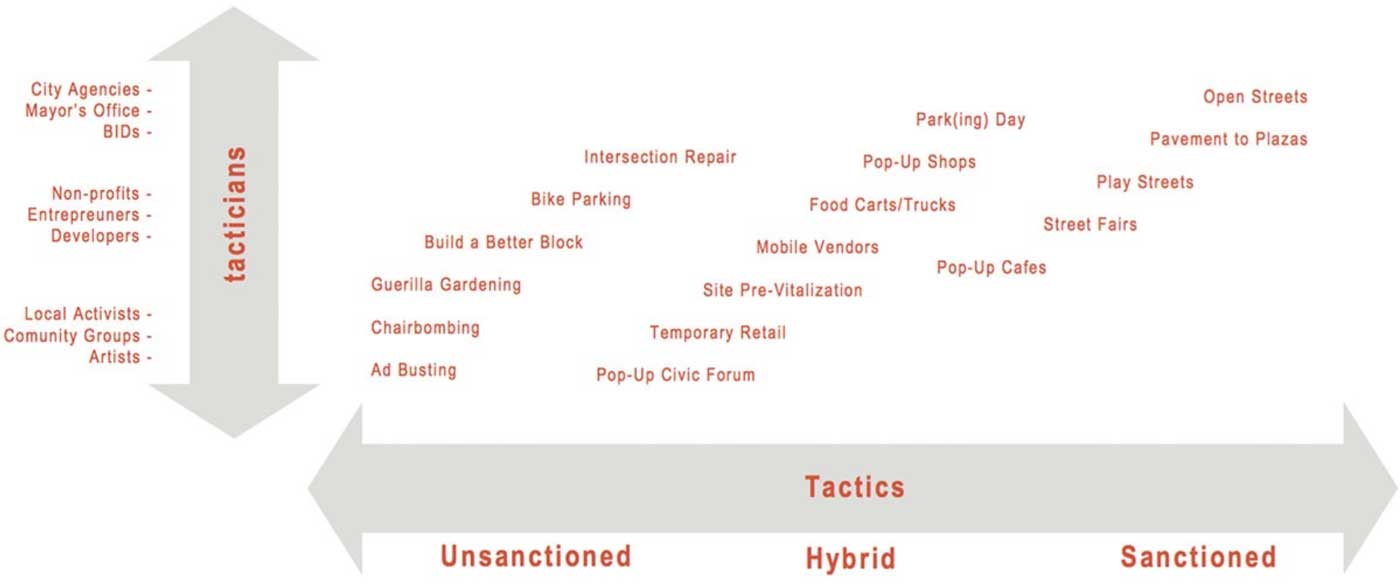Why Tactical Urbanism is key to revitalizing cities

Tactical Urbanism is a fundamental placemaking tool for including citizens in shaping their own community. Here’s an extensive primer on what Tactical Urbanism is, what it looks like and how you can initiate or participate in your own community.
What is Tactical Urbanism?
Tactical Urbanism is a ‘short term action for long term’ approach to downtown revitalization using low-cost, scalable placemaking interventions that inform long-term investment. It is used by citizen groups, businesses, nonprofits and governments, and combines an open development process with the creativity unleashed by social interaction. The result? Better informed decisions in triple-bottom-line (economically, socially, environmentally beneficial) placemaking.
- Why Tactical Urbanism?
- What are examples of Tactical Urbanism?
- What are the benefits of Tactical Urbanism?
- Short videos of Tactical Urbanism
- What are the most common applications of Tactical Urbanism?
- Case Study: Rose Kennedy Greenway, Boston
- Your tactical urbanism ideas, many supported by NR Future’s Future Five grant program
- Where can I learn more about Tactical Urbanism?
Why Tactical Urbanism?
Today’s vacant lots, empty storefronts, overly wide streets, highway underpasses, surface parking lots, and other underused public spaces remain prominent in our towns and cities and have become the targets of entrepreneurs, artists, forward-thinking government officials, and civic-minded “hacktivists.” Such groups increasingly view the city as a laboratory for testing ideas in real time, and their actions have led to a variety of creative and entrepreneurial initiatives.
What are examples of Tactical Urbanism?
See the chart and list below, organized by sanctioned (government partnered) and unsanctioned projects, and whether they are executed by artists/activists, nonprofits/businesses, or government agencies.
- Site Pre-Vitalization – Temporary activation of a development site, often using shipping containers. Cooltown post.
Underutilized Streets:
- Open Streets – Massive temporary street closures like Ciclovía and summer street closings in NY, SF. Cooltown post. Open Streets Project.
- Play Streets – Repurposing parking lots and streets from car usage to kid usage. Partnership for a Healthier America: Play Streets
- Better Block – A weekend pop-up demonstration of what a main street could be, gone viral. Cooltown post. The Better Block.
- Pavement to Plazas – Transforming auto-oriented streets into pedestrian plazas. Cooltown post. NYC Plaza Program, Pavement to Plazas initiative.
- Intersection Repair – Transforming neighborhood street intersections into neighborhood squares, mainly via paint and street closures. City Repair: Intersection Repair.
Vacant Spaces:
- Guerilla Gardening – Re-purposing underutilized lots for ‘social gardening’. GuerillaGardening.org.
- Park(ing) Day – Crowdsourcing parking spaces into ‘third places’ for a day. Cooltown post. Park(ing) Day. (See image above, in Portland, OR.)
- Pop-Up Retail – Temporary stores in vacant spaces, prevalent in every major city. Cooltown posts.
- Pop-Up Parks – Transforming streetside parking spaces into micro parks. Park(ing) Day types of places, but for months. Cooltown post. City of San Francisco: Pavement to Parks. City of NY: Street Seats.
- Depave – Green city movement to remove unnecessary paving and replace with green spaces. Depave organization.
- Park-Making – Reclaiming underutilized sites for parks. Cooltown article.
- Parkmobiles – Movable landscaped containers that can placed in a standard on-street parking space. Parkmobiles.
Guerilla Intervention
- Chair Bombing – Homemade seating in public spaces “to improve comfort, social activity, and sense of place”. DoTank: Chair Bombing.
- Informal Bike Parking – Non-government installed bike racks that are functional indications of where permanent bike parking is needed.
- Ad-Busting – Removing and altering of billboards and large advertising signage. Ad busting on Tumblr.
- Reclaimed Setbacks – Activating front yards to become more community-oriented.
- Weed Bombing – Converting weed overgrowth into landscaped works of art. Weed bombing on Tumblr.
Entrepreneurial Development
- Food Carts/Trucks – Essentially pop-up cafes on wheels, prevalent in most every major city. Cooltown post.
- Mobile Vendors – Aka street vendors, and including bicycle vendors.
- Micro-Mixing – Mixing multiple businesses in a single retail space, like a cafe, bar, bookstore, theater: Cooltown article.
Social Change
- Pop-Up Town Hall – A non-government meeting space to discuss the future of one’s city.
- Camps – Temporary occupying of space with intention of social change (i.e. Occupy movement), disaster relief, or experimentation/prototyping (Burning Man).
What are the benefits of Tactical Urbanism?
Tactical Urbanism is a learned response to the slow and siloed conventional city building process. For citizens, it allows the immediate reclamation, redesign, or reprogramming of public space. For advocacy organizations, it is a way to show what is possible to garner public and political support. For developers or entrepreneurs, it provides a means of collecting design intelligence from the market they intend to serve. And for government, it’s a way to implement best practices with immediacy. These interventions were never anticipated by a master plan, but provide a needed dose of innovation and creativity, helping citizens not only envision a more vibrant downtown, but experience it too. And therein lies the seductive power of Tactical Urbanism: It creates low-cost, tactile proposals for change instead of plans or computer-generated renderings that remain abstract. If the project doesn’t work as planned, the budget is minimally affected, and future designs may be calibrated to absorb the lessons learned. If done well, the small-scale and temporary changes serve as the first step in informing long-term investment. This iterative process not only creates better projects but also continues the momentum established during the conventional planning process.
Short videos of Tactical Urbanism
What are the most common applications of Tactical Urbanism?
- Initiated by citizens to bypass the conventional project delivery process and cut through municipal bureaucracy by prototyping or visually demonstrating the possibility of change. This is what the NR Future monthly grant program directly supports.
- As a tool for city government, developers or nonprofits to more broadly engage the public during project planning, delivery, and development processes.
- As a “phase 0” early implementation tool used by cities or developers to test projects before a long-term investment is made. In the United States, phase 0 applications are popping up from coast to coast. Since 2007, the NYDOT has been partnering with local BIDs and advocacy groups to transform acres of asphalt into temporary plazas, curb extensions, and pedestrian refuges, some of which have already made their way to permanence.
Case Study: Rose Kennedy Greenway, Boston
Tactical Urbanism can be used to initiate new places or help repair existing ones. For example, when Boston’s $22 billion “Big Dig” buried the Central Artery expressway and made room for the 15-acre Rose Kennedy Greenway, the new public green space needed to be activated. In a 2010 editorial, the Boston Globe asserted, “What could be a monument to Boston’s collective spirit is instead a victim of the region’s parochial rhythms.” Architecture critic Robert Campbell put it this way: “There are things to look at but nothing to do.” In response to his critique, and many others, the Rose Kennedy Greenway Conservancy began activating the forlorn spaces. Demonstration gardens, street art, food trucks, and low-cost movable tables and chairs have breathed new life into the greenway. These low-cost modifications were never part of the master plan per se but demonstrate that improving otherwise lifeless public spaces need not cost millions of dollars.

Your tactical urbanism ideas, many supported by NR Future’s Future Five grant program:
[bubbly-entries tag=tactical recently=”rated”]
- Tactical Urbanism articles on this site
- Tactical Urbanism wikipedia page
- Free guide: Tactical Urbanism 2: Short-Term Action, Long Term Change pdf
- Tactical Urbanism Facebook Page (news)
- Tactical Urbanism Facebook Group (peer-to-peer exchange)
- The official book: Tactical Urbanism: Short-term Action for Long-term Change
- Tactical Urbanism Course
- Tactical Urbanism videos


Leave a Reply